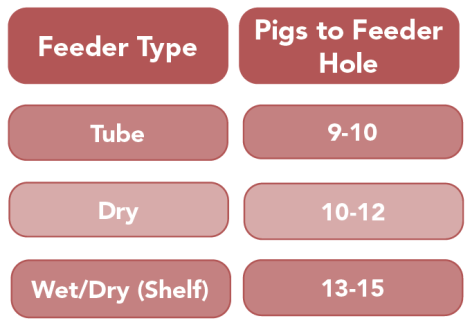
In the midst of record feed prices paced by $7-8/bu corn, in-barn feeder management should be a top priority for all producers. Spending over $100/pig in feed cost is already painful enough and shouldn’t be exacerbated by improper feeders or feeder settings.
I tend to break feeder management into 3 buckets:
- Selecting the right feeder for your barn
- Having proper pig:feeder utilization rates
- Setting the feeder correctly to maximize feed efficiency and gain.
Having the proper feeder in your barn is a decision that may have been made 10-20 years previously. However, there may be compelling evidence that retrofitting a barn with an updated feeder may actually make economical sense. The three main types of feeders are tube, dry, and wet/dry (shelf) feeders.
Tube feeders were a common choice in barn builds back in the 90’s and early 2000’s. They are cheap, relatively durable and maximize Feed per unit of gain (FG) in finisher pigs. Unfortunately, they have little to no in-barn feed storage and can be difficult to manage for maximized Average Daily Gain (ADG).
Dry feeders were a nice improvement to maximize in-barn feed storage and minimize out of feed events. They also improved on how many pigs could be fed per feeder space. Below is a table showing how many pigs would be recommended per feeder space for the three types of feeders.
Lastly, wet/dry feeders improved even further allowing for 13-15 pigs per feeder space. In addition, they maintained the FG that was supported by dry feeders and improved on the ADG capacity of the feeder. In a recent set of trials conducted by Pipestone Applied Research, wet/dry feeders improved ADG while maintaining FG. In addition, they reduced water wastage by almost 0.5 gal/pig/day. When considering all of this, retrofitting a wean-to-finish barn with wet/dry feeders still resulted in a positive Return on Investment (ROI) of less than 3 years. In addition, it reduced the carbon footprint by reducing water usage. It’s important to note that wet/dry feeders can be more challenging to manage, especially for nursery pigs; and in my opinion, wouldn’t be recommended for nursery barns, but would be appropriate for wean-to-finish or finisher barns.

Even with the correct feeder selection and proper feeder utilization rates, all could still be lost if the feeder isn’t set correctly. Nursery pigs are much less likely to waste feed, and during the first 3-4 weeks I encourage producers to leave feeders relatively open to encourage feed intake. This might mean leaving feeders with 60-70% pan coverage. If pigs are utilizing a wet/dry feeder in the nursery period, having the feeder water turned on and supplemental nipple bar turned off around 15-21 days post placement is also important. This encourages water intake at the feeder which in turn should encourage feed intake. As pigs approach 50 lbs, I believe it’s important to start reducing pan coverage culminating in the finisher with ~30% pan coverage. This still allows for proper feed intake to maximize gain, but also minimizes feed wastage and improves FG.
Though it can be frustrating to adjust feeders multiple times a week or even multiple times a day, it can easily pay for itself. A recent study from Kansas State University showed that going from 40% to 90% pan coverage worsened FG in the finisher by ~4%. This would mean those pigs roughly wasted an additional 22 lbs of feed per pig or close to $4.00 in added feed cost. In a 2400 head barn that’s $9,600 which compared against the time required to adjust feeders is a relatively small investment.
As feeder technology advances and feed costs fluctuate, improving on feeder management is increasingly important and can have significant effects on a producer’s profitability. Retrofitting barns with older feeders should continue even with the high cost of stainless steel. Improving FG, maximizing pig growth and minimizing feed and water wastage is critical to being a profitable and sustainable pig farmer, and it all starts with the feeder.
Article by: Jon De Jong President, Pipestone Nutrition
